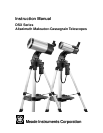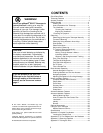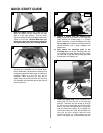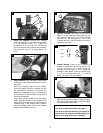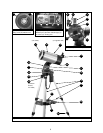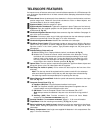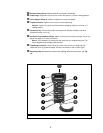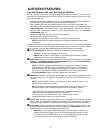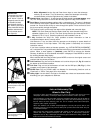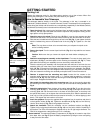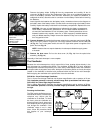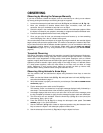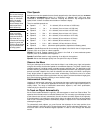
7
An important array of features and manual controls facilitates operation of a DSX telescope. Be
sure to become acquainted with all of these controls before attempting observations through
the telescope.
b Focus Knob:
Moves the telescope’s focus drawtube in a finely-controlled motion
to achieve
precise image focus. Rotate the focus knob clockwise to focus on distant objects, and
counterclockwise to focus on nearby objects.
c Eyepiece Holder: Holds the eyepiece in place.
d Eyepiece Holder Thumbscrew: Tightens the eyepiece in place. Tighten to a firm feel only.
e Eyepiece: Place the supplied eyepiece into the eyepiece holder and tighten in place with
thumbscrew (4, Fig.1d).
f Viewfinder Alignment Screws: Adjust these screws to align the viewfinder. See pages 12
and 13 for more information.
g
Viewfinder: Provides an easier way to initially sight objects than the main telescope eyepiece
which has a narrower field of view.
See page 11 for more information.
h Viewfinder Alignment Bracket: Attaches the viewfinder to the telescope.
i
Flip-Mirror Control Knobs:
DSX telescopes include an internal mirror. With the flip-mirror
control in the “up” position, as shown in Fig. 1d, light is diverted to the eyepiece. With the
flip-mirror control in the “down” position, light proceeds straight out the photo port for
photography.
j Altitude Setting Circle and Lock
A) Altitude Setting Circle: Displays Altitude (vertical) coordinates (A, Fig. Ib).
B) Altitude Lock: Controls the manual vertical movement of the telescope. Turning
the Altitude lock counterclockwise unlocks the telescope enabling it to be freely
tilted by hand on the vertical axis. Turning the Altitude lock clockwise (to a firm
feel only) prevents the telescope from being moved manually and engages the
vertical motor drive clutch for Autostar operation (B, Fig. Ib).
1) Optical Tube: The main optical component that gathers the light from distant objects and
brings this light to a focus for observation with the eyepiece.
1! Dust Cap (not visible in photo): Pull to remove the dust cap from the front lens of the
telescope.
Note: The dust cap should be replaced and the power turned off to the telescope
after each observing session. Verify that any dew that might have collected during
the observing session has evaporated prior to replacing the dust cap.
1@ Mount, Mounting Arm and Shaft: Holds the optical tube assembly. Attaches to the tripod
base (15, Fig. 1a).
1# Computer Control Panel (Fig. 1c)
A. Handbox (HBX) Port: Plug the Autostar handbox into this port.
B. LED: The red power indicator light illuminates when power is supplied to the con-
nected handbox and to the telescope’s motor drive.
C. ON Switch: Turns the Computer Control Panel and Autostar ON or OFF.
Note: Always remove the batteries if they are not to be used for a long period of
time.
D. Auxiliary (AUX) Port:
Provides connection for current and future Meade
accessories. See
OPTIONAL ACCESSORIES, page 37.
1$ Autostar Handbox: See AUTOSTAR FEATURES, pages 8 - 10 for more information.
1% Tripod Base: Holds the mounting arm assembly (12, Fig. 1a) in place.
1^ Base Lock Knob (not visible in photo): Attaches mounting arm assembly to tripod base.
Loosen before moving the optical tube on the horizontal axis. See page 16 for more
information.
1& Battery Compartment: Install eight user-supplied AA batteries in this compartment. See
page 11 for more information.
TELESCOPE FEATURES



